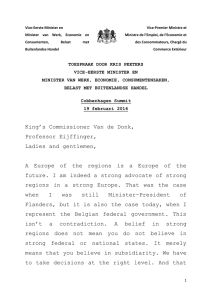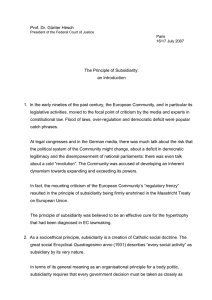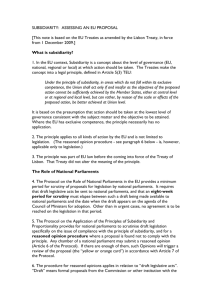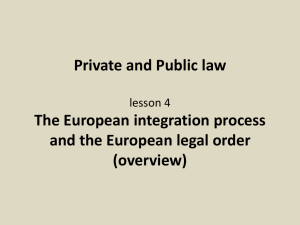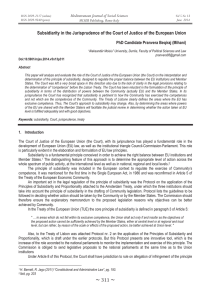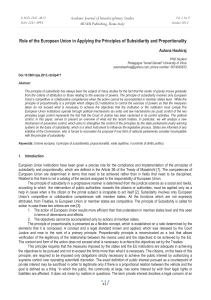The principle of subsidiarity and its application
advertisement
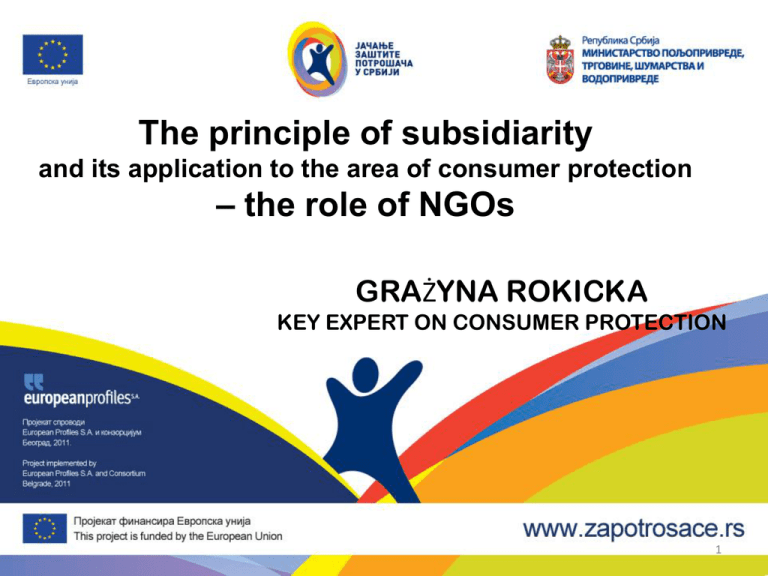
The principle of subsidiarity and its application to the area of consumer protection – the role of NGOs GRAŻYNA ROKICKA KEY EXPERT ON CONSUMER PROTECTION 1 SUBSIDIARITY IN THE EUROPEAN UNION Fundamental principle of the EU The Lisbon Treaty, art. 5.3 of TEU: - distribution of legislative powers among different players of public sphere at the lowest possible and efficient level. - applies to all EU institutions (in particular Council, Parliament and Commission). VERTICAL SUBSIDIARITY 2 SUBSIDIARITY IN THE EUROPEAN UNION EU is a complex, multi-level and ‘multi-actors’ system, which cannot be reduced to a simple relationship between EU and states. EU’s policy making process already involves public and private actors. ‘Horizontal’ dimension of the principle of subsidiarity idea of participation and citizenship public and private actors 3 SUBSIDIARITY IN THE EUROPEAN UNION ‘Horizontal’ subsidiarity entails that the EU: - delegates some aspects of public policy making to non-state actors such as business, NGOs, foundations and other interested participants of civil society; - restrains itself from directly legislating on a specific issue, leaving room to agreements between interested parties; - recognizes the public role of the social actors and grants them regulatory powers. 4 ORDERING SOCIETY ACCORDING TO THE SUBSIDIARITY PRINCIPLE International institutions State (government) Intermediate organizations The individual & family Only when needed should a higher level be appealed to – respect to freedom and initiative at lower levels. Intermediate organizations (NGO’s, Political Parties, Churches, Labor Unions, Cultural Societies) have a legitimate and necessary role to play in a society Family is the basic unit of society Published by Sr. Katherine Feely, SND on: www.educationforjustice.org 5 “HORIZONTAL” SUBSIDIARITY Sharing of competences and initiatives between public and private actors. All proposals start bottom-up rather than top-down. Each higher level must bring help to the lowers: - family helps the person, - civic organizations help the family, - state helps society. 6 ‘HORIZONTAL’ SUBSIDIARITY AND THE STATE The state exists to assist the persons / families/ intermediates present within the society to achieve their own goals. The sphere of the state is active but limited mainly to safeguarding the common good/public interest and maintaining public order. Two aspects of horizontal subsidiarity: - the state should not intervene unless it is necessary, but - it should intervene when it is necessary. 7 SHARING OF COMPETENCES AND INITIATIVES BETWEEN PUBLIC AND PRIVATE ACTORS Subsidiarity is a way: - to supply the means for consumer protection; - to move resources to support and help consumer organizations without making them passive; - to accomplish COs’ tasks, namely to do what they should do, what is up to them and not to others. Public institutions should not undertake tasks which can be (better) conducted by consumer organizations but should support them in accomplishing their tasks. 8 SHARING OF COMPETENCES AND INITIATIVES BETWEEN PUBLIC AND PRIVATE ACTORS Best recognized tasks of consumer organizations (to be supported by the state): • advice and legal support to consumers; • information and communication; • representation and direct advocacy actions; • educational activities; • research, studies and comparative tests of products; • direct intervention in policies. 9 PARTICIPATION OF COS IN PUBLIC POLICY Consumer organizations should be involved: - in the field of consumer policy making with the aim to protect consumer rights and care for common goods / general interest (setting-up agenda, planning, decision, implementation, evaluation of ways to manage public problems); - in the management of consumer issues / implementation of the policy in order to increase the resources and enhance the legitimacy of public intervention. 10 BOTTOM-UP DIRECTION ACCORDING TO THE SUBSIDIARITY PRINCIPLE Consumers have to be not only consulted and/or involved by state institutions in the policy making process, but that they are entitled to take autonomous initiatives, without necessarily waiting for the institutions to take the first step. Example: proposals of activities to be funded by the state in order to protect consumers’ interest coming from COs 11 Thank you for your attention! HVALA NA PAŽNJI! g.rokicka@zapotrosace.rs 12

